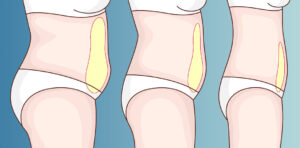- Exercise Regularly: Regular exercise can help to strengthen the muscles around the joints and improve joint flexibility and mobility. Low-impact activities such as swimming, cycling, and walking are good options.
- Maintain a Healthy Weight: Being overweight or obese can put additional strain on the joints, particularly the knees and hips. Maintaining a healthy weight can reduce the risk of developing joint problems or exacerbating existing issues. Here are some remedies that can help, especially if you are accumulating weight around your midsection.
- Practice Good Posture: Poor posture can lead to joint pain and stiffness. Women should practice good posture by sitting and standing up straight, avoiding hunching over electronic devices, and using ergonomic furniture.
- Eat a Balanced Diet: A balanced diet rich in nutrients such as vitamin D, calcium, and omega-3 fatty acids can support joint health. Women should aim to eat a variety of fruits, vegetables, lean protein, and whole grains.
- Manage Stress: Stress can worsen joint pain and inflammation. Women should try to manage stress through activities such as meditation, yoga, or deep breathing exercises.
- Avoid High-Impact Activities: Activities that put a lot of stress on the joints, such as running or jumping, can exacerbate joint issues. Women should opt for low-impact activities instead.
- Seek Medical Attention: Women experiencing joint pain or other symptoms should seek medical attention promptly to receive an accurate diagnosis and appropriate treatment. Early intervention can help prevent further damage and improve outcomes. If you want to seek home remedies, here are some ways you can explore.

Nancy Grace
Researcher and Science Writer
Nancy specializes in science journalism and factual information in the fields of health, medicine, and nutrition. She spends hours each week pouring through 100s of medical journals and research studies to increase accessibility to the depths of information by the everyday person.



